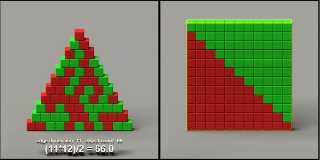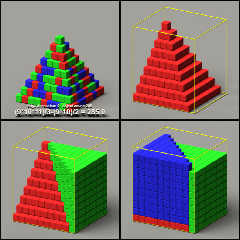 |
 |
|
 |
|
 |
|  |
|  |
|
 |
|
 |
|  |
|  |
|
 |
Hi everyone,
Today I figured out a couple of mathematical expressions to find the
number of bricks for any given 2d or 3d pyramid. I had previously
figured out the 2d version, but the equation was a bloated monstrosity.
The new one is much simpler!
My approach is a geometric one, where I try to fit a number of
asymmetrical (but numerically correct) versions of the pyramid into a
box or cube. The 2d version is rather straight-forward, while the 3d
version is a bit more complex.
In these images I attempt to illustrate the idea behind this method.
Displayed as text is the initial edge dimension. This is followed by the
object count acquired from an incremental value calculated as each
object was laid. Below that is the equation describing the number of
elements. This is calculated automatically at the time of parsing, based
on the edge dimension (concatenation of strings and all that). The total
number is given again as a proof that the method works. Following the
initial image, other images tell a story about how I came to arrive at a
working equation.
I know this has probably been done before, countless times, but it sure
was fun to arrive at this independently! It was a good mental exercise.
Now, for you math theorists out there, what is the next logical step in
the progression? I can see the equation as an extension of the 3d
version, but what would the object look like? Composed of hexagonal
prisms, perhaps...
Sam
Post a reply to this message
Attachments:
Download 'pyramid_math2d.jpg' (31 KB)
Download 'pyramid_math3d.jpg' (109 KB)
Preview of image 'pyramid_math2d.jpg'

Preview of image 'pyramid_math3d.jpg'

|
 |
|  |
|  |
|
 |
|
 |
|  |
|  |
|
 |
stbenge wrote:
> Hi everyone,
>
> Today I figured out a couple of mathematical expressions to find the
> number of bricks for any given 2d or 3d pyramid. I had previously
> figured out the 2d version, but the equation was a bloated
> monstrosity. The new one is much simpler!
http://pirate.shu.edu/~wachsmut/ira/infinity/answers/sm_sq_cb.html
2D pyramid = 1 + 2 + 3 + .. + n
= n * (n + 1) / 2
3D pyramid = 1 + 2^2 + 3^2 + .. + n^2
= n * (n + 1) * (2n + 1) / 6
Ray
Post a reply to this message
|
 |
|  |
|  |
|
 |
|
 |
|  |
|  |
|
 |
Ray Bellis wrote:
> stbenge wrote:
>> Hi everyone,
>>
>> Today I figured out a couple of mathematical expressions to find the
>> number of bricks for any given 2d or 3d pyramid. I had previously
>> figured out the 2d version, but the equation was a bloated
>> monstrosity. The new one is much simpler!
>
> http://pirate.shu.edu/~wachsmut/ira/infinity/answers/sm_sq_cb.html
>
> 2D pyramid = 1 + 2 + 3 + .. + n
> = n * (n + 1) / 2
>
> 3D pyramid = 1 + 2^2 + 3^2 + .. + n^2
> = n * (n + 1) * (2n + 1) / 6
Yeah well, like I said, it was fun to come up with this independently. I
wonder if anyone else has used a similar geometric approach?
Sam
Post a reply to this message
|
 |
|  |
|  |
|
 |
|
 |
|  |
|  |
|
 |
stbenge <stb### [at] hotmail com> wrote:
> Ray Bellis wrote:
> > stbenge wrote:
> >> Hi everyone,
> >>
> >> Today I figured out a couple of mathematical expressions to find the
> >> number of bricks for any given 2d or 3d pyramid. I had previously
> >> figured out the 2d version, but the equation was a bloated
> >> monstrosity. The new one is much simpler!
> >
> > http://pirate.shu.edu/~wachsmut/ira/infinity/answers/sm_sq_cb.html
> >
> > 2D pyramid = 1 + 2 + 3 + .. + n
> > = n * (n + 1) / 2
> >
> > 3D pyramid = 1 + 2^2 + 3^2 + .. + n^2
> > = n * (n + 1) * (2n + 1) / 6
>
> Yeah well, like I said, it was fun to come up with this independently. I
> wonder if anyone else has used a similar geometric approach?
>
> Sam
you cant just leave it like that.
4D pyramid = 1 + 2^3 + 3^3 + .. + n^3 com> wrote:
> Ray Bellis wrote:
> > stbenge wrote:
> >> Hi everyone,
> >>
> >> Today I figured out a couple of mathematical expressions to find the
> >> number of bricks for any given 2d or 3d pyramid. I had previously
> >> figured out the 2d version, but the equation was a bloated
> >> monstrosity. The new one is much simpler!
> >
> > http://pirate.shu.edu/~wachsmut/ira/infinity/answers/sm_sq_cb.html
> >
> > 2D pyramid = 1 + 2 + 3 + .. + n
> > = n * (n + 1) / 2
> >
> > 3D pyramid = 1 + 2^2 + 3^2 + .. + n^2
> > = n * (n + 1) * (2n + 1) / 6
>
> Yeah well, like I said, it was fun to come up with this independently. I
> wonder if anyone else has used a similar geometric approach?
>
> Sam
you cant just leave it like that.
4D pyramid = 1 + 2^3 + 3^3 + .. + n^3
Post a reply to this message
|
 |
|  |
|  |
|
 |
|
 |
|  |
|  |
|
 |
alphaQuad wrote:
>> Yeah well, like I said, it was fun to come up with this independently. I
>> wonder if anyone else has used a similar geometric approach?
>>
>> Sam
>
> you cant just leave it like that.
>
> 4D pyramid = 1 + 2^3 + 3^3 + .. + n^3
>
>
Where did you get that long decimal number?
I am more of a hacker than a mathematician or even a programmer. Before
that, I use art as a visualization tool. Somehow though, I think there
must be an approach to finding the brick count in 2d and 3d pyramids
without the use of long decimal numbers. I'm thinking something like
this might work:
4d pyramid? =
n*(n+1)*(n+2)*(n+3)/4
-n*(n+1)*(n+2)/3
-n*(n+1)/2
It would be an extension of my 3d method:
3d pyramid =
n*(n+1)*(n+2)/2
-n*(n+1)/2
Of course, that 4d pyramid expression is probably wrong. It seems too
simple a solution. Any time something is too easy, I quickly find out
that there was a reason...
Sam
Post a reply to this message
|
 |
|  |
|  |
|
 |
|
 |
|  |
|  |
|
 |
stbenge napsal(a):
> alphaQuad wrote:
>>> Yeah well, like I said, it was fun to come up with this independently. I
>>> wonder if anyone else has used a similar geometric approach?
>>>
>>> Sam
>>
>> you cant just leave it like that.
>>
>> 4D pyramid = 1 + 2^3 + 3^3 + .. + n^3
>>
>>
>
> Where did you get that long decimal number?
>
> I am more of a hacker than a mathematician or even a programmer. Before
> that, I use art as a visualization tool. Somehow though, I think there
> must be an approach to finding the brick count in 2d and 3d pyramids
> without the use of long decimal numbers. I'm thinking something like
> this might work:
>
> 4d pyramid? =
> n*(n+1)*(n+2)*(n+3)/4
> -n*(n+1)*(n+2)/3
> -n*(n+1)/2
>
> It would be an extension of my 3d method:
>
> 3d pyramid =
> n*(n+1)*(n+2)/2
> -n*(n+1)/2
>
> Of course, that 4d pyramid expression is probably wrong. It seems too
> simple a solution. Any time something is too easy, I quickly find out
> that there was a reason...
>
> Sam
you say:
> n*(n+1)*(n+2)*(n+3)/4
> -n*(n+1)*(n+2)/3
> -n*(n+1)/2
I guess:
> n*(n+1)*(n+2)*(n+3)/4
> -n*(n+1)*(n+2)/3
> +n*(n+1)/2
or:
> n*(n+1)*(n+2)*(n+3)/4
> -n*(n+1)*(n+2)/3
Post a reply to this message
|
 |
|  |
|  |
|
 |
|
 |
|  |
|
 |




![]()